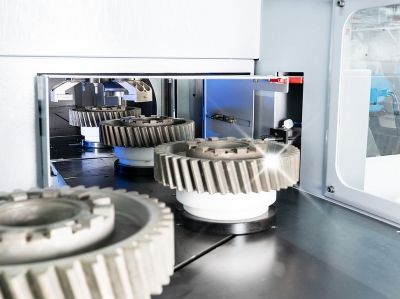IMTS Digital Technology Showcase: EMAG
What will the cars on the street look like in the future? A new study by the Boston Consulting Group forecasts a mix of gasoline and diesel engines (48 percent), hybrid vehicles (33 percent) and completely electric (19 percent). For OEM’s and supply companies, this means that there will be a variety of conventional components, such as transmission gears, as well as new transmission components, produced in the future – in alternation and with a large amount of cost-pressure. The EMAG VLC 350 GT turning/grinding machine shows how this challenging task can be implemented, efficiently, in production. Different hard machining processes are performed on chucked components with a maximum diameter of up to 350 millimeters in succession and in a single clamping operation. Users benefit from a flexible solution with an excellent price-performance ratio.
Large output quantities, precise machining processes and massive cost pressure— transmission manufacturing requirements are demanding and will only become more demanding in the future as the automotive industry continues to evolve in this area. It is likely that in the future, there will be even more transmission variations to consider. How can manufacturers meet these challenges? EMAG provides a striking answer to this question with its VLC GT series, one of the most successful innovations released by the South German company in recent months. Two years ago, the VLC 200 GT was released - the “GT” in the name stands for “grinding” and “turning”. It hints at the main strength of this machine: the combination of grinding and turning (and additional processes) with the proven pick-up automation from EMAG, allowing for countless manufacturing solutions. This variety of technology allows the machine to cover the entire range of machining operations required for transmission components.
With the introduction of the VLC 350 GT machine to the market, EMAG is expanding on the capabilities of the VLC 200 GT and can machine components up to 350 millimeters (14 in) in diameter. With this system, for the first time ever EMAG can offer the option of integrating a grinding spindle with an NC swiveling axis. This can hold, for example, cylindrical grinding elements for grinding internal bore holes. What is the overall strategy behind this new development? “Among other things, we are aiming at developing solutions for manufacturing processes with smaller batch sizes that inevitably involve many retooling processes,” explains Marina Manger from EMAG Sales. “In these applications, the fact that the machine includes several different grinding spindles from the outset is an obvious advantage. The machining area also provides plenty of space, so the machine is ready to handle any task.”
(Learn more in the August 2020 issue of Gear Technology)





